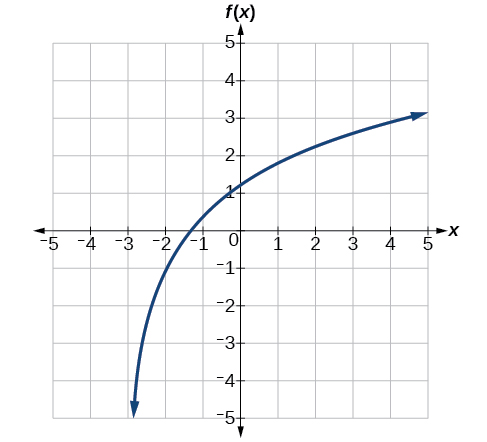Section 6.2 – Logarithmic Functions and Their Graphs
Learning Objectives
Welcome to Section 6.2! In this section you will…
- Convert from logarithmic to exponential form.
- Convert from exponential to logarithmic form.
- Evaluate logarithms.
- Use common logarithms.
- Use natural logarithms.
- Identify the domain and range of a logarithmic function.
- Graph logarithmic functions.

In 2010, a major earthquake struck Haiti, destroying or damaging over 285,000 homes. One year later, another, stronger earthquake devastated Honshu, Japan, destroying or damaging over 332,000 buildings, like those shown in Figure 1. Even though both caused substantial damage, the earthquake in 2011 was 100 times stronger than the earthquake in Haiti. How do we know? The magnitudes of earthquakes are measured on a scale known as the Richter Scale. The Haitian earthquake registered a 7.0 on the Richter Scale whereas the Japanese earthquake registered a 9.0.
The Richter Scale is a base-ten logarithmic scale. In other words, an earthquake of magnitude 8 is not twice as great as an earthquake of magnitude 4. It is [latex]10^{8−4}=10^4=10,000[/latex] times as great! In this lesson, we will investigate the nature of the Richter Scale and the base-ten function upon which it depends.
Converting from Logarithmic to Exponential Form
In order to analyze the magnitude of earthquakes or compare the magnitudes of two different earthquakes, we need to be able to convert between logarithmic and exponential form. For example, suppose the amount of energy released from one earthquake were 500 times greater than the amount of energy released from another. We want to calculate the difference in magnitude. The equation that represents this problem is [latex]10^x=500[/latex], where [latex]x[/latex] represents the difference in magnitudes on the Richter Scale. How would we solve for [latex]x[/latex]?
We have not yet learned a method for solving exponential equations. None of the algebraic tools discussed so far is sufficient to solve [latex]10^x=500[/latex]. We know that [latex]10^2=100[/latex] and [latex]10^3=1000[/latex], so it is clear that [latex]x[/latex] must be some value between 2 and 3, since [latex]y=10^x[/latex] is increasing. We can examine a graph, as in Figure 2, to better estimate the solution.
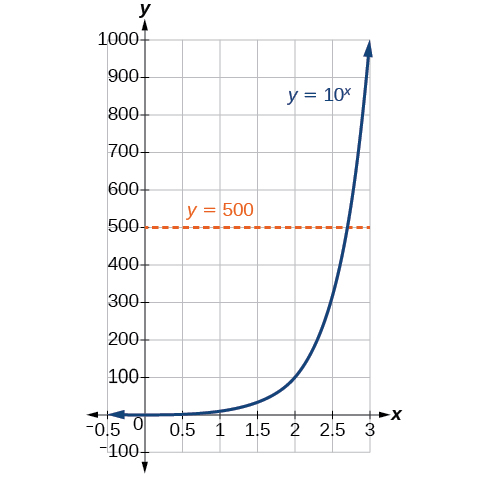
Estimating from a graph, however, is imprecise. To find an algebraic solution, we must introduce a new function. Observe that the graph in Figure 2 passes the horizontal line test. The exponential function [latex]y=b^x[/latex] is one-to-one, so its inverse, [latex]x=b^y[/latex] is also a function. As is the case with all inverse functions, we simply interchange [latex]x[/latex] and [latex]y[/latex] and solve for [latex]y[/latex] to find the inverse function. To represent [latex]y[/latex] as a function of [latex]x[/latex], we use a logarithmic function of the form [latex]y=log_b(x)[/latex]. The base [latex]b[/latex] logarithm of a number is the exponent by which we must raise [latex]b[/latex] to get that number.
We read a logarithmic expression as, “The logarithm with base [latex]b[/latex] of [latex]x[/latex] is equal to [latex]y[/latex], ” or, simplified, “log base [latex]b[/latex] of [latex]x[/latex] is [latex]y[/latex]. ” We can also say, “ [latex]b[/latex] raised to the power of [latex]y[/latex] is [latex]x[/latex], ” because logs are exponents. For example, the base 2 logarithm of 32 is 5, because 5 is the exponent we must apply to 2 to get 32. Since [latex]2^5=32[/latex], we can write [latex]log_232=5[/latex]. We read this as “log base 2 of 32 is 5.”
We can express the relationship between logarithmic form and its corresponding exponential form as follows:
Note that the base [latex]b[/latex] is always positive.

Because logarithm is a function, it is most correctly written as [latex]log_b(x)[/latex], using parentheses to denote function evaluation, just as we would with [latex]f(x)[/latex]. However, when the input is a single variable or number, it is common to see the parentheses dropped and the expression written without parentheses, as [latex]log_bx[/latex]. Note that many calculators require parentheses around the [latex]x[/latex].
We can illustrate the notation of logarithms as follows:

Notice that, comparing the logarithm function and the exponential function, the input and the output are switched. This means [latex]y=log_bx[/latex] and [latex]y=b^x[/latex] inverse functions.
Definition of the Logarithmic Function
A logarithm base [latex]b[/latex] of a positive number [latex]x[/latex] satisfies the following definition.
For [latex]x>0,b>0,b≠1[/latex],
where,
- we read [latex]log_b(x)[/latex] as, “the logarithm with base [latex]b[/latex] of [latex]x[/latex] ” or the “log base [latex]b[/latex] of [latex]x[/latex].”
- the logarithm [latex]y[/latex] is the exponent to which [latex]b[/latex] must be raised to get[latex]x[/latex].
Also, since the logarithmic and exponential functions switch the [latex]x[/latex] and [latex]y[/latex] values, the domain and range of the exponential function are interchanged for the logarithmic function. Therefore,
- the domain of the logarithm function with base [latex]b[/latex] is [latex](0,∞)[/latex].
- the range of the logarithm function with base [latex]b[/latex] is [latex](−∞,∞)[/latex].
Q&A
Can we take the logarithm of a negative number?
No. Because the base of an exponential function is always positive, no power of that base can ever be negative. We can never take the logarithm of a negative number. Also, we cannot take the logarithm of zero. Calculators may output a log of a negative number when in complex mode, but the log of a negative number is not a real number.
How To
Given an equation in logarithmic form [latex]log_bx=y[/latex], convert it to exponential form.
- Examine the equation [latex]y=log_b(x)[/latex] and identify [latex]b[/latex], [latex]y[/latex], and [latex]x[/latex].
- Rewrite [latex]log_b(x)=y[/latex] as [latex]b^y=x[/latex].
Example 1
Converting from Logarithmic Form to Exponential Form
Write the following logarithmic equations in exponential form.
ⓐ [latex]log_6(\sqrt{6})=\frac{1}{2}[/latex]
ⓑ [latex]log_3(9)=2[/latex]
Show/Hide Solution
Solution
First, identify the values of [latex]b[/latex], [latex]y[/latex], and [latex]x[/latex]. Then, write the equation in the form [latex]b^y=x[/latex].
ⓐ [latex]log_6(\sqrt{6})=\frac{1}{2}[/latex]
Here [latex]b=6[/latex], [latex]y=\frac{1}{2}[/latex], and [latex]x=\sqrt{6}[/latex]. Therefore, the equation [latex]log_6(\sqrt{6})=\frac{1}{2}[/latex] is equivalent to:
[latex]6^{\frac{1}{2}}=\sqrt{6}[/latex].
ⓑ [latex]log_3(9)=2[/latex]
Here [latex]b=3[/latex], [latex]y=2[/latex], and [latex]x=9[/latex]. Therefore, the equation [latex]log_3(9)=2[/latex] is equivalent to [latex]3^2=9[/latex].
Try It #1
Write the following logarithmic equations in exponential form.
ⓐ [latex]log_{10}(1,000,000)=6[/latex]
ⓑ [latex]log_5(25)=2[/latex]
Converting from Exponential to Logarithmic Form
To convert from exponents to logarithms, we follow the same steps in reverse. We identify the base [latex]b[/latex], exponent [latex]x[/latex], and output [latex]y[/latex]. Then we write [latex]x=log_b(y)[/latex].
Example 2
Converting from Exponential Form to Logarithmic Form
Write the following exponential equations in logarithmic form.
ⓐ [latex]2^3=8[/latex]
Show/Hide Solution
Solution
First, identify the values of [latex]b[/latex], [latex]y[/latex], and [latex]x[/latex]. Then, write the equation in the form [latex]x=log_b(y)[/latex].
Here [latex]b=2[/latex], [latex]x=3[/latex], and [latex]y=8[/latex]. Therefore, the equation [latex]2^3=8[/latex] is equivalent to [latex]log_2(8)=3[/latex].
Here [latex]b=5[/latex], [latex]x=2[/latex], and [latex]y=25[/latex]. Therefore, the equation [latex]5^2=25[/latex] is equivalent to [latex]log_5(25)=2[/latex].
Here [latex]b=10[/latex], [latex]x=−4[/latex], and [latex]y=\frac{1}{10,000}[/latex]. Therefore, the equation [latex]10^{−4}=\frac{1}{10,000}[/latex] is equivalent to [latex]log_{10}(\frac{1}{10,000})=−4[/latex].
Try It #2
Write the following exponential equations in logarithmic form.
ⓐ [latex]3^2=9[/latex]
ⓑ [latex]5^3=125[/latex]
ⓒ [latex]2^{−1}=\frac{1}{2}[/latex]
Evaluating Logarithms
Knowing the squares, cubes, and roots of numbers allows us to evaluate many logarithms mentally. For example, consider [latex]log_28[/latex]. We ask, “To what exponent must [latex]2[/latex] be raised in order to get 8?” Because we already know [latex]2^3=8[/latex], it follows that [latex]log_28=3[/latex].
Now consider solving [latex]log_749[/latex] and [latex]log_327[/latex] mentally.
- We ask, “To what exponent must 7 be raised in order to get 49?” We know [latex]7^2=49[/latex]. Therefore, [latex]log_749=2[/latex]
- We ask, “To what exponent must 3 be raised in order to get 27?” We know [latex]3^3=27[/latex]. Therefore, [latex]log_327=3[/latex]
Even some seemingly more complicated logarithms can be evaluated without a calculator. For example, let’s evaluate [latex]log_{\frac{2}{3}}\frac{4}{9}[/latex] mentally.
- We ask, “To what exponent must [latex]\frac{2}{3}[/latex] be raised in order to get [latex]\frac{4}{9}[/latex]? ” We know [latex]2^2=4[/latex] and [latex]3^2=9[/latex], so [latex](\frac{2}{3})^2=\frac{4}{9}[/latex]. Therefore, [latex]log_{\frac{2}{3}}(\frac{4}{9})=2[/latex].
How To
Given a logarithm of the form [latex]y=log_b(x)[/latex], evaluate it mentally.
- Rewrite the argument [latex]x[/latex] as a power of [latex]b[/latex]: [latex]b^y=x[/latex].
- Use previous knowledge of powers of [latex]b[/latex] identify [latex]y[/latex] by asking, “To what exponent should [latex]b[/latex] be raised in order to get [latex]x[/latex]? ”
Example 3
Solving Logarithms Mentally
Solve [latex]y=log_4(64)[/latex] without using a calculator.
Show/Hide Solution
Solution
First we rewrite the logarithm in exponential form: [latex]4^y=64[/latex]. Next, we ask, “To what exponent must 4 be raised in order to get 64?”
We know
Therefore,
[latex]log_4(64)=3[/latex]
Try It #3
Solve [latex]y=log_{121}(11)[/latex] without using a calculator.
Example 4
Evaluating the Logarithm of a Reciprocal
Evaluate [latex]y=log_3(\frac{1}{27})[/latex] without using a calculator.
Show/Hide Solution
Solution
First we rewrite the logarithm in exponential form: [latex]3^y=\frac{1}{27}[/latex]. Next, we ask, “To what exponent must 3 be raised in order to get [latex]\frac{1}{27}[/latex]? ”
We know [latex]3^3=27[/latex], but what must we do to get the reciprocal, [latex]\frac{1}{27}[/latex]? Recall from working with exponents that [latex]b^{−a}=\frac{1}{b^a}[/latex]. We use this information to write

Therefore, [latex]log_3(\frac{1}{27})=−3[/latex].
Try It #4
Evaluate [latex]y=log_2(\frac{1}{32})[/latex] without using a calculator.
Using Common Logarithms
Sometimes you may see a logarithm written without a base. When you see one written this way, you need to look at the expression before evaluating it. It may be that the base you use doesn’t matter. If you find it in computer science, it often means [latex]log_2(x)[/latex]. However, in mathematics it almost always means the common logarithm of 10. In other words, the expression [latex]log(x)[/latex] often means [latex]log_{10}(x)[/latex].
Definition of the Common Logarithm
A common logarithm is a logarithm with base [latex]10[/latex]. We write [latex]log_{10}(x)[/latex] simply as [latex]log(x)[/latex]. The common logarithm of a positive number [latex]x[/latex] satisfies the following definition.
For [latex]x>0[/latex],
We read [latex]log(x)[/latex] as, “the logarithm with base [latex]10[/latex] of [latex]x[/latex] ” or “log base 10 of [latex]x[/latex]. ”
The logarithm [latex]y[/latex] is the exponent to which [latex]10[/latex] must be raised to get [latex]x[/latex].
Properties of the Common Logarithm
| Property | Reason |
| 1. [latex]log_a1=0[/latex] | We must raise [latex]a[/latex] to the power [latex]0[/latex] to get [latex]1[/latex]. |
| 2. [latex]log_aa=1[/latex] | We must raise [latex]a[/latex] to the power [latex]1[/latex] to get [latex]a[/latex]. |
| 3. [latex]log_aa^x=x[/latex] | We must raise [latex]a[/latex] to the power [latex]x[/latex] to get [latex]a^x[/latex]. |
| 4. [latex]a^{log_ax}=x[/latex] | [latex]log_ax[/latex] is the power to which [latex]a[/latex] must be raised to get [latex]x[/latex]. |
How To
Given a common logarithm of the form [latex]y=log(x)[/latex], evaluate it mentally.
- Rewrite the argument [latex]x[/latex] as a power of [latex]10[/latex]: [latex]10^y=x[/latex].
- Use previous knowledge of powers of [latex]10[/latex] to identify [latex]y[/latex] by asking, “To what exponent must [latex]10[/latex] be raised in order to get [latex]x[/latex]? ”
Example 5
Finding the Value of a Common Logarithm Mentally
Evaluate [latex]y=log(1000)[/latex] without using a calculator.
Show/Hide Solution
Solution
First we rewrite the logarithm in exponential form: [latex]10^y=1000[/latex]. Next, we ask, “To what exponent must [latex]10[/latex] be raised in order to get 1000?” We know
Therefore, [latex]log(1000)=3[/latex].
Try It #5
Evaluate [latex]y=log(1,000,000)[/latex].
Example 6
Applying the Value of a Common Logarithm
Let’s investigate the opening problem to this chapter using a logarithmic formula for magnitude based on the intensity.
The intensity levels, [latex]I[/latex], of two earthquakes measured on a seismograph can be compared by the formula:
[latex]log(\frac{I_2}{I_1})=M_2-M_1[/latex] ,
where [latex]M[/latex] is the magnitude given by the Richter Scale.
In 2010, a major earthquake struck Haiti, destroying or damaging over 285,000 homes. One year later, another, stronger earthquake devastated Honshu, Japan, destroying or damaging over 332,000 buildings. Even though both caused substantial damage, the earthquake in 2011 was 100 times stronger than the earthquake in Haiti. How do we know? The magnitudes of earthquakes are measured on a scale known as the Richter Scale. The Haitian earthquake registered a [latex]7.0[/latex] on the Richter Scale whereas the Japanese earthquake registered a [latex]9.0[/latex]. Approximately, how many times greater was the intensity of the first earthquake compared to more recent one?
Show/Hide Solution
Solution
Since we know that the magnitude of the first earthquake in Haiti was [latex]7.0[/latex] and the magnitude of the next earthquake in Japan was [latex]9.0[/latex], then we have the following.
[latex]M_1=7.0[/latex] and [latex]M_2=9.0[/latex]
Now, we can insert these values into the formula given.
[latex]log(\frac{I_2}{I_1})=9.0-7.0=2[/latex]
Based on the definition of a common logarithm, [latex]y=log(x)[/latex] is equivalent to [latex]10^y=x[/latex] such that we can rewrite this argument as a power of [latex]10[/latex].
[latex]log(\frac{I_2}{I_1})=2 ⇒ 10^2=\frac{I_2}{I_1}[/latex]
Solving this reformed equation, we get the following result.
[latex]I_2=100(I_1)[/latex]
Based on this conclusion, the Japanese earthquake in 2011 was [latex]100[/latex] times more intense than the Haitian earthquake in 2010.
Using Natural Logarithms
The most frequently used base for logarithms is [latex]e[/latex]. Base [latex]e[/latex] logarithms are important in calculus and some scientific applications; they are called natural logarithms. The base [latex]e[/latex] logarithm, [latex]log_e(x)[/latex], has its own notation, [latex]ln(x)[/latex].
Most values of [latex]ln(x)[/latex] can be found only using a calculator. The major exception is that, because the logarithm of 1 is always 0 in any base, [latex]ln(1)=0[/latex]. For other natural logarithms, we can use the [latex]ln[/latex] key that can be found on most scientific calculators. We can also find the natural logarithm of any power of [latex]e[/latex] using the inverse property of logarithms.
Definition of the Natural Logarithm
A natural logarithm is a logarithm with base [latex]e[/latex]. We write [latex]log_e(x)[/latex] simply as [latex]ln(x)[/latex]. The natural logarithm of a positive number [latex]x[/latex] satisfies the following definition.
For [latex]x>0[/latex],
We read [latex]ln(x)[/latex] as, “the logarithm with base [latex]e[/latex] of [latex]x[/latex] ” or “the natural logarithm of [latex]x[/latex]. ”
The logarithm [latex]y[/latex] is the exponent to which [latex]e[/latex] must be raised to get [latex]x[/latex].
Since the functions [latex]y=e^x[/latex] and [latex]y=ln(x)[/latex] are inverse functions, [latex]ln(e^x)=x[/latex] for all [latex]x[/latex] and [latex]e^{ln(x)}=x[/latex] for [latex]x>0[/latex].
Properties of the Natural Logarithm
| Property | Reason |
| 1. [latex]ln(1)=0[/latex] | We must raise [latex]e[/latex] to the power [latex]0[/latex] to get [latex]1[/latex]. |
| 2. [latex]ln(e)=1[/latex] | We must raise [latex]e[/latex] to the power [latex]1[/latex] to get [latex]e[/latex]. |
| 3. [latex]ln(e^x)=x[/latex] | We must raise [latex]e[/latex] to the power [latex]x[/latex] to get [latex]e^x[/latex]. |
| 4. [latex]e^{ln(x)}=x[/latex] | [latex]ln(x)[/latex] is the power to which [latex]e[/latex] must be raised to get [latex]x[/latex]. |
Graphs of Logarithmic Functions
In Graphs of Exponential Functions, we saw how creating a graphical representation of an exponential model gives us another layer of insight for predicting future events. How do logarithmic graphs give us insight into situations? Because every logarithmic function is the inverse function of an exponential function, we can think of every output on a logarithmic graph as the input for the corresponding inverse exponential equation. In other words, logarithms give the cause for an effect.
To illustrate, suppose we invest $[latex]2500[/latex] in an account that offers an annual interest rate of [latex]5[/latex]%, compounded continuously. We already know that the balance in our account for any year [latex]t[/latex] can be found with the equation [latex]A=2500e^{0.05t}[/latex].
But what if we wanted to know the year for any balance? We would need to create a corresponding new function by interchanging the input and the output; thus we would need to create a logarithmic model for this situation. By graphing the model, we can see the output (year) for any input (account balance). For instance, what if we wanted to know how many years it would take for our initial investment to double? Figure 3 shows this point on the logarithmic graph.

Finding the Domain of a Logarithmic Function
Before working with graphs, we will take a look at the domain (the set of input values) for which the logarithmic function is defined.
Recall that the exponential function is defined as [latex]y=b^x[/latex] for any real number [latex]x[/latex] and constant [latex]b>0[/latex], [latex]b≠1[/latex], where
- The domain of [latex]y[/latex] is [latex](−∞,∞)[/latex].
- The range of [latex]y[/latex] is [latex](0,∞)[/latex].
In the last section we learned that the logarithmic function [latex]y=log_b(x)[/latex] is the inverse of the exponential function [latex]y=b^x[/latex]. So, as inverse functions:
- The domain of [latex]y=log_b(x)[/latex] is the range of [latex]y=b^x[/latex]: [latex](0,∞)[/latex].
- The range of [latex]y=log_b(x)[/latex] is the domain of [latex]y=b^x[/latex]: [latex](−∞,∞)[/latex].
Transformations of the parent function [latex]y=log_b(x)[/latex] behave similarly to those of other functions. Just as with other parent functions, we can apply the four types of transformations—shifts, stretches, compressions, and reflections—to the parent function without loss of shape.
In Graphs of Exponential Functions we saw that certain transformations can change the range of [latex]y=b^x[/latex]. Similarly, applying transformations to the parent function [latex]y=log_b(x)[/latex] can change the domain. When finding the domain of a logarithmic function, therefore, it is important to remember that the domain consists only of positive real numbers. That is, the argument of the logarithmic function must be greater than zero.
For example, consider [latex]f(x)=log_4(2x−3)[/latex]. This function is defined for any values of [latex]x[/latex] such that the argument, in this case [latex]2x−3[/latex], is greater than zero. To find the domain, we set up an inequality and solve for [latex]x[/latex]:

In interval notation, the domain of [latex]f(x)=log_4(2x−3)[/latex] is [latex](1.5,∞)[/latex].
How To
Given a logarithmic function, identify the domain.
- Set up an inequality showing the argument greater than zero.
- Solve for [latex]x[/latex].
- Write the domain in interval notation.
Example 7
Identifying the Domain of a Logarithmic Shift
What is the domain of [latex]f(x)=log_2(x+3)[/latex]?
Show/Hide Solution
Solution
The logarithmic function is defined only when the input is positive, so this function is defined when [latex]x+3>0[/latex]. Solving this inequality,

The domain of [latex]f(x)=log_2(x+3)[/latex] is [latex](−3,∞)[/latex].
Try It #6
What is the domain of [latex]f(x)=log_5(x−2)+1[/latex]?
Example 8
Identifying the Domain of a Logarithmic Shift and Reflection
What is the domain of [latex]f(x)=log(5−2x)[/latex]?
Show/Hide Solution
Solution
The logarithmic function is defined only when the input is positive, so this function is defined when [latex]5–2x>0[/latex]. Solving this inequality,

The domain of [latex]f(x)=log(5−2x)[/latex] is [latex](–∞,\frac{5}{2})[/latex].
Try It #7
What is the domain of [latex]f(x)=log(x−5)+2[/latex]?
Graphing Logarithmic Functions
Now that we have a feel for the set of values for which a logarithmic function is defined, we move on to graphing logarithmic functions. The family of logarithmic functions includes the parent function [latex]y=log_b(x)[/latex] along with all its transformations: shifts, stretches, compressions, and reflections.
We begin with the parent function [latex]y=log_b(x)[/latex]. Because every logarithmic function of this form is the inverse of an exponential function with the form [latex]y=b^x[/latex], their graphs will be reflections of each other across the line [latex]y=x[/latex]. To illustrate this, we can observe the relationship between the input and output values of [latex]y=2^x[/latex] and its equivalent [latex]x=log_2(y)[/latex] in Table 1.
|
[latex]x[/latex]
|
[latex]−3[/latex]
|
[latex]−2[/latex]
|
[latex]−1[/latex]
|
[latex]0[/latex]
|
[latex]1[/latex]
|
[latex]2[/latex]
|
[latex]3[/latex]
|
|
[latex]2^x=y[/latex]
|
[latex]18[/latex]
|
[latex]14[/latex]
|
[latex]12[/latex]
|
[latex]1[/latex]
|
[latex]2[/latex]
|
[latex]4[/latex]
|
[latex]8[/latex]
|
|
[latex]log_2(y)=x[/latex]
|
[latex]−3[/latex]
|
[latex]−2[/latex]
|
[latex]−1[/latex]
|
[latex]0[/latex]
|
[latex]1[/latex]
|
[latex]2[/latex]
|
[latex]3[/latex]
|
Using the inputs and outputs from Table 1, we can build another table to observe the relationship between points on the graphs of the inverse functions [latex]f(x)=2^x[/latex] and [latex]g(x)=log_2(x)[/latex]. See Table 2.
|
[latex]f(x)=2^x[/latex]
|
[latex](−3,\frac{1}{8})[/latex]
|
[latex](−2,\frac{1}{4})[/latex]
|
[latex](−1,\frac{1}{2})[/latex]
|
[latex](0,1)[/latex]
|
[latex](1,2)[/latex]
|
[latex](2,4)[/latex]
|
[latex](3,8)[/latex]
|
|
[latex]g(x)=log_2(x)[/latex]
|
[latex](\frac{1}{8},−3)[/latex]
|
[latex](\frac{1}{4},−2)[/latex]
|
[latex](\frac{1}{2},−1)[/latex]
|
[latex](1,0)[/latex]
|
[latex](2,1)[/latex]
|
[latex](4,2)[/latex]
|
[latex](8,3)[/latex]
|
As we’d expect, the x– and y-coordinates are reversed for the inverse functions. Figure 4 shows the graph of [latex]f[/latex] and [latex]g[/latex].

Observe the following from the graph:
- [latex]f(x)=2^x[/latex] has a y-intercept at [latex](0,1)[/latex] and [latex]g(x)=log_2(x)[/latex] has an x– intercept at [latex](1,0)[/latex].
- The domain of [latex]f(x)=2^x[/latex], [latex](−∞,∞)[/latex], is the same as the range of [latex]g(x)=log_2(x)[/latex].
- The range of [latex]f(x)=2^x[/latex], [latex](0,∞)[/latex], is the same as the domain of [latex]g(x)=log_2(x)[/latex].
Characteristics of the Graph of the Logarithmic Parent Function
For any real number [latex]x[/latex] and constant [latex]b>0[/latex], [latex]b≠1[/latex], we can see the following characteristics in the graph of [latex]f(x)=log_b(x)[/latex]:
- one-to-one function
- vertical asymptote: [latex]x=0[/latex]
- domain: [latex](0,∞)[/latex]
- range: [latex](−∞,∞)[/latex]
- x-intercept: [latex](1,0)[/latex] and key point [latex](b,1)[/latex]
- y-intercept: none
- increasing if [latex]b>1[/latex]
- decreasing if [latex]0
See Figure 5.
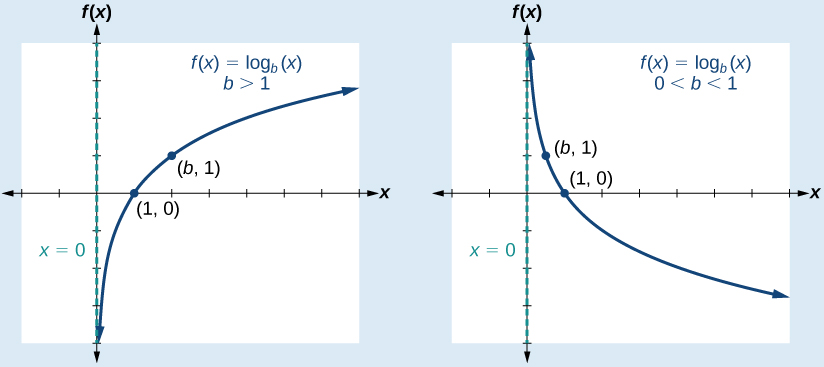
Figure 6 shows how changing the base [latex]b[/latex] in [latex]f(x)=log_b(x)[/latex] can affect the graphs. Observe that the graphs compress vertically as the value of the base increases. (Note: recall that the function [latex]ln(x)[/latex] has base [latex]e≈2.718[/latex].)
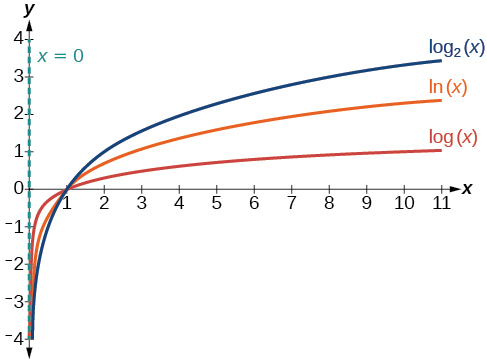
How To
Given a logarithmic function with the form [latex]f(x)=log_b(x)[/latex], graph the function.
- Draw and label the vertical asymptote, [latex]x=0[/latex].
- Plot the x-intercept, [latex](1,0)[/latex].
- Plot the key point [latex](b,1)[/latex].
- Draw a smooth curve through the points.
- State the domain, [latex](0,∞)[/latex], the range, [latex](−∞,∞)[/latex], and the vertical asymptote, [latex]x=0[/latex].
Example 9
Graphing a Logarithmic Function with the Form [latex]f(x)=log_b(x)[/latex].
Graph [latex]f(x)=log_5(x)[/latex]. State the domain, range, and asymptote.
Show/Hide Solution
Solution
Before graphing, identify the behavior and key points for the graph.
- Since [latex]b=5[/latex] is greater than one, we know the function is increasing. The left tail of the graph will approach the vertical asymptote [latex]x=0[/latex], and the right tail will increase slowly without bound.
- The x-intercept is [latex](1,0)[/latex].
- The key point [latex](5,1)[/latex] is on the graph.
- We draw and label the asymptote, plot and label the points, and draw a smooth curve through the points (see Figure 7).
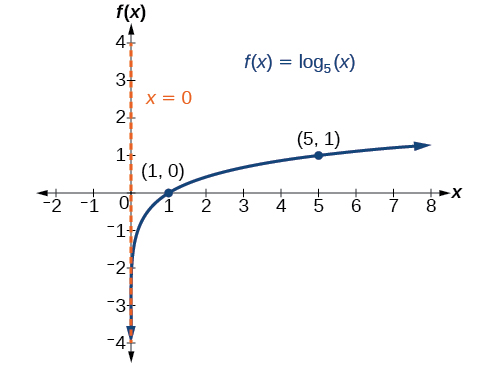
The domain is [latex](0,∞)[/latex], the range is [latex](−∞,∞)[/latex], and the vertical asymptote is [latex]x=0[/latex].
Try It #8
Graph [latex]f(x)=log_{\frac{1}{5}}(x)[/latex]. State the domain, range, and asymptote.
Graphing Transformations of Logarithmic Functions
As we mentioned in the beginning of the section, transformations of logarithmic graphs behave similarly to those of other parent functions. We can shift, stretch, compress, and reflect the parent function [latex]y=log_b(x)[/latex] without loss of shape.
Graphing a Horizontal Shift of Logarithmic Functions
When a constant [latex]c[/latex] is added to the input of the parent function [latex]f(x)=log_b(x)[/latex], the result is a horizontal shift [latex]c[/latex] units in the opposite direction of the sign on [latex]c[/latex]. To visualize horizontal shifts, we can observe the general graph of the parent function [latex]f(x)=log_b(x)[/latex] and for [latex]c>0[/latex] alongside the shift left, [latex]g(x)=log_b(x+c)[/latex], and the shift right, [latex]h(x)=log_b(x−c)[/latex]. See Figure 8.
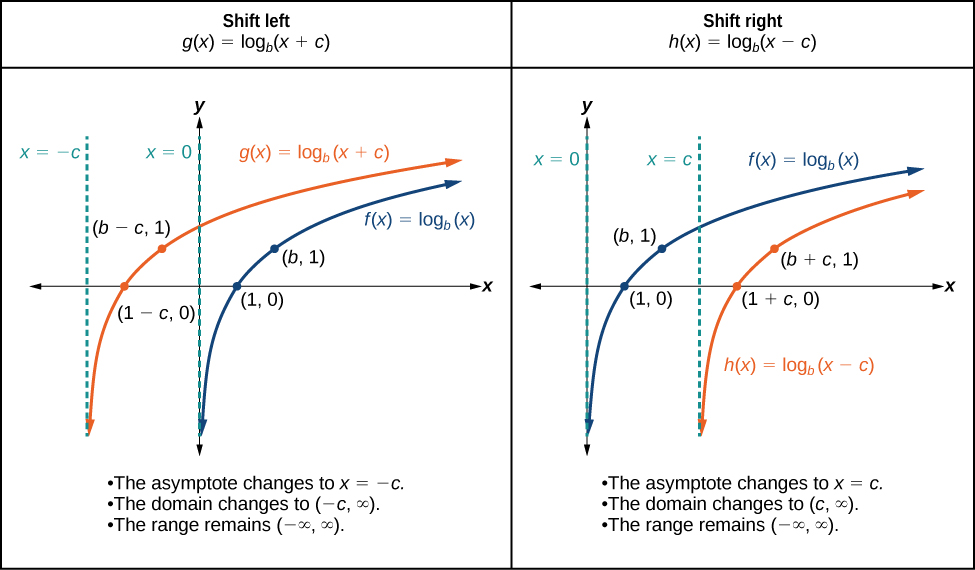
Graphing a Vertical Shift of Logarithmic Functions
When a constant [latex]d[/latex] is added to the parent function [latex]f(x)=log_b(x)[/latex], the result is a vertical shift [latex]d[/latex] units in the direction of the sign on [latex]d[/latex]. To visualize vertical shifts, we can observe the general graph of the parent function [latex]f(x)=log_b(x)[/latex] alongside the shift up, [latex]g(x)=log_b(x+d)[/latex] and the shift down, [latex]h(x)=log_b(x−d)[/latex]. See Figure 9.
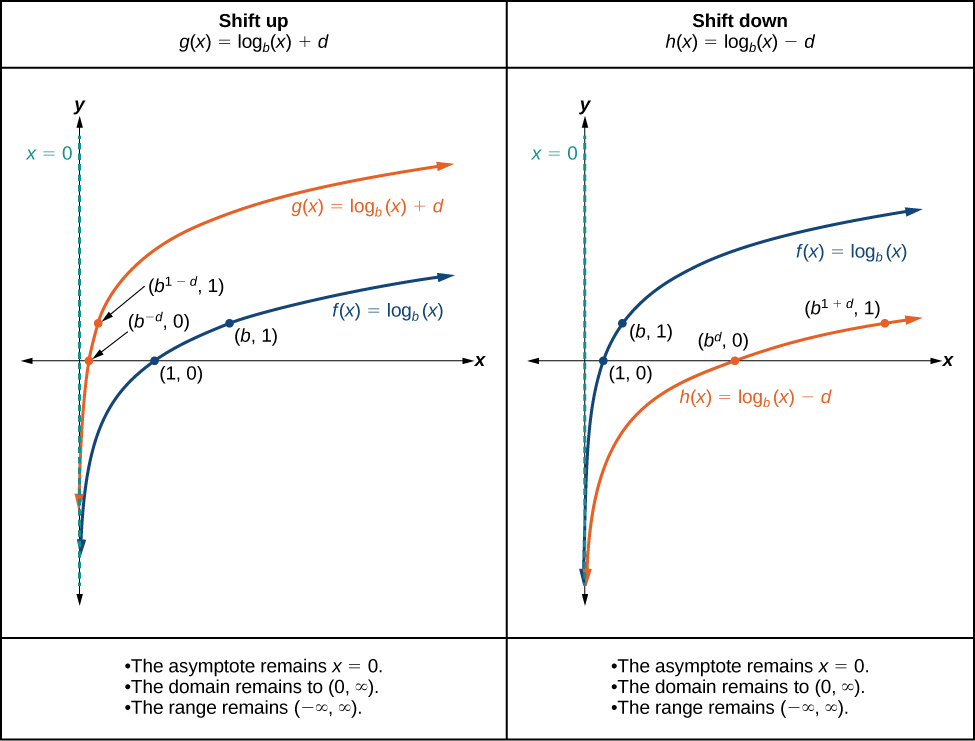
Graphing Stretches and Compressions of Logarithmic Functions
When the parent function [latex]f(x)=log_b(x)[/latex] is multiplied by a constant [latex]a>0[/latex], the result is a vertical stretch or compression of the original graph. To visualize stretches and compressions, we set [latex]a>1[/latex] and observe the general graph of the parent function [latex]f(x)=log_b(x)[/latex] alongside the vertical stretch, [latex]g(x)=alog_b(x)[/latex] and the vertical compression, [latex]h(x)=\frac{1}{a}log_b(x)[/latex]. See Figure 10.
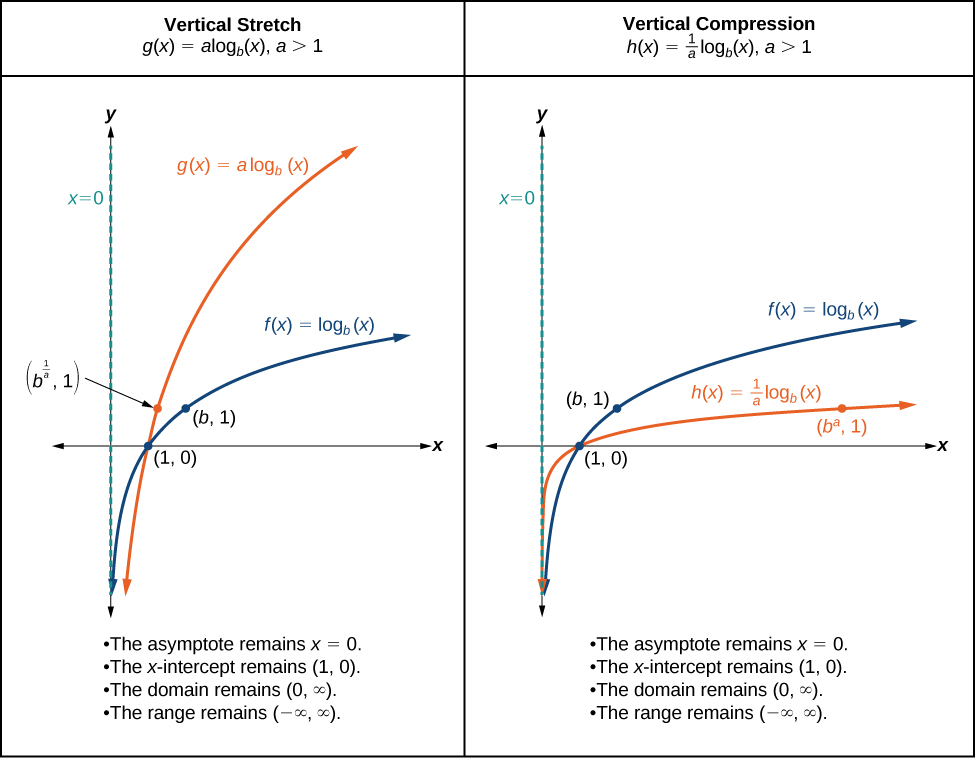
Graphing Reflections of Logarithmic Functions
When the parent function [latex]f(x)=log_b(x)[/latex] is multiplied by [latex]−1[/latex], the result is a reflection about the x-axis. When the input is multiplied by [latex]−1[/latex], the result is a reflection about the y-axis. To visualize reflections, we restrict [latex]b>1[/latex], and observe the general graph of the parent function [latex]f(x)=log_b(x)[/latex] alongside the reflection about the x-axis, [latex]g(x)=−log_b(x)[/latex] and the reflection about the y-axis, [latex]h(x)=log_b(−x)[/latex]. See Figure 11.

Summarizing Translations of the Logarithmic Function
Now that we have worked with each type of translation for the logarithmic function, we can summarize each in Table 4 to arrive at the general equation for translating exponential functions.
|
Translations of the Parent Function [latex]y=log_b(x)[/latex] |
|
|
Translation |
Form |
|
Shift
|
[latex]y=log_b(x+c)+d[/latex]
|
|
Stretch and Compress
|
[latex]y=alog_b(x)[/latex]
|
|
Reflect about the x-axis |
[latex]y=−log_b(x)[/latex]
|
|
Reflect about the y-axis |
[latex]y=log_b(−x)[/latex]
|
|
General equation for all translations |
[latex]y=alog_b(x+c)+d[/latex]
|
Translations of Logarithmic Functions
All translations of the parent logarithmic function, [latex]y=log_b(x)[/latex], have the form
where the parent function, [latex]y=log_b(x)[/latex], [latex]b>1[/latex], is
- shifted vertically up [latex]d[/latex] units.
- shifted horizontally to the left [latex]c[/latex] units.
- stretched vertically by a factor of [latex]a[/latex] if [latex]a>0[/latex].
- compressed vertically by a factor of [latex]a[/latex] if [latex]0
- reflected about the x-axis when [latex]a<0[/latex].
For [latex]f(x)=log(−x)[/latex], the graph of the parent function is reflected about the y-axis.
Characteristics of the Graph of Translations of the Logarithmic Parent Function
For any real number [latex]x[/latex] and constant [latex]b>0[/latex], [latex]b≠1[/latex], we can see the following characteristics in the graph of [latex] f(x)=alog_b(x+c)+d[/latex]:
- one-to-one function
- vertical asymptote: [latex]x=c[/latex]
- domain: [latex](−c,∞)[/latex]
- range: [latex](−∞,∞)[/latex]
- x-intercept: [latex](b^{\frac{−d}{a}}−c,0)[/latex] and key point [latex](b^{\frac{1−d}{a}}−c,1)[/latex]
- y-intercept: [latex](0, alog_b(c)+d)[/latex]
- increasing if [latex]b>1[/latex]
- decreasing if [latex]0
Example 10
Finding the Vertical Asymptote of a Logarithm Graph
What is the vertical asymptote of [latex]f(x)=−2log_3(x+4)+5[/latex]?
Show/Hide Solution
Solution
The vertical asymptote is at [latex]x=−4[/latex].
Analysis
The coefficient, the base, and the upward translation do not affect the asymptote. The shift of the curve 4 units to the left shifts the vertical asymptote to [latex]x=−4[/latex].
Try It #9
What is the vertical asymptote of [latex]f(x)=3+ln(x−1)[/latex]?
Example 11
Finding the Equation from a Graph
Find a possible equation for the common logarithmic function graphed in Figure 12.
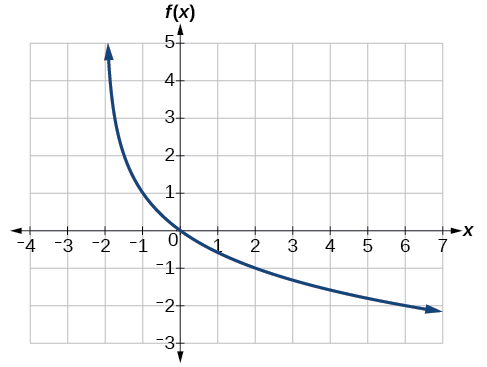
Show/Hide Solution
Solution
This graph has a vertical asymptote at [latex]x=–2[/latex] and has been vertically reflected. We do not know yet the vertical shift or the vertical stretch. We know so far that the equation will have form:
It appears the graph passes through the points [latex](–1,1)[/latex] and [latex](2,–1)[/latex]. Substituting [latex](–1,1)[/latex],

Next, substituting in [latex](2,–1)[/latex],

This gives us the equation [latex]f(x)=–\frac{2}{log(4)}log(x+2)+1[/latex].
Analysis
We can verify this answer by comparing the function values in Table 5 with the points on the graph in Figure 12.
|
[latex]x[/latex]
|
−1 |
0 |
1 |
2 |
3 |
|
[latex]f(x)[/latex]
|
1 |
0 |
−0.58496 |
−1 |
−1.3219 |
|
[latex]x[/latex]
|
4 |
5 |
6 |
7 |
8 |
|
[latex]f(x)[/latex]
|
−1.5850 |
−1.8074 |
−2 |
−2.1699 |
−2.3219 |
Q&A
Is it possible to tell the domain and range and describe the end behavior of a function just by looking at the graph?
Yes, if we know the function is a general logarithmic function. For example, look at the graph in Figure 13. The graph approaches [latex]x=−3[/latex] (or thereabouts) more and more closely, so [latex]x=−3[/latex] is, or is very close to, the vertical asymptote. It approaches from the right, so the domain is all points to the right, [latex]{x | x>−3}[/latex]. The range, as with all general logarithmic functions, is all real numbers. And we can see the end behavior because the graph goes down as it goes left and up as it goes right. The end behavior is that as [latex]x→−3^+[/latex],[latex]f(x)→−∞[/latex] and as [latex]x→∞[/latex],[latex]f(x)→∞[/latex].
Media
Access this online resource for additional instruction and practice with logarithms.
- Introduction to Logarithms
- Graph an Exponential Function and Logarithmic Function
- Match Graphs with Exponential and Logarithmic Functions
- Find the Domain of Logarithmic Functions
Section Exercises
Verbal
1. What is a base [latex]b[/latex] logarithm? Discuss the meaning by interpreting each part of the equivalent equations [latex]b^y=x[/latex] and [latex]log_bx=y[/latex] for [latex]b>0[/latex], [latex]b≠1[/latex].
2. How is the logarithmic function [latex]f(x)=log_bx[/latex] related to the exponential function [latex]g(x)=b^x[/latex]? What is the result of composing these two functions?
3. How can the logarithmic equation [latex]log_bx=y[/latex] be solved for [latex]x[/latex] using the properties of exponents?
4. Discuss the meaning of the natural logarithm. What is its relationship to a logarithm with base [latex]b[/latex], and how does the notation differ?
5. The inverse of every logarithmic function is an exponential function and vice-versa. What does this tell us about the relationship between the coordinates of the points on the graphs of each?
6. What type(s) of translation(s), if any, affect the range of a logarithmic function?
7. What type(s) of translation(s), if any, affect the domain of a logarithmic function?
8. Does the graph of a general logarithmic function have a horizontal asymptote? Explain.
Algebraic
For the following exercises, rewrite each equation in exponential form.
9. [latex]log_a(b)=c[/latex]
10. [latex]log_4(q)=m[/latex]
11. [latex]log_{15}(a)=b[/latex]
12. [latex]log_{13}(142)=a[/latex]
13. [latex]ln(w)=n[/latex]
For the following exercises, rewrite each equation in logarithmic form.
14. [latex]c^d=k[/latex]
15. [latex]19^x=y[/latex]
16. [latex]y^x=\frac{39}{100}[/latex]
17. [latex]e^k=h[/latex]
For the following exercises, solve for [latex]x[/latex] by converting the logarithmic equation to exponential form.
18. [latex]log_2(x)=−3[/latex]
19. [latex]ln(x)=2[/latex]
For the following exercises, use the definition of common and natural logarithms to simplify.
20. [latex]log(100^8)[/latex]
21. [latex]10^{log(32)}[/latex]
22. [latex]ln(e^{−5.03})[/latex]
23. [latex]e^{ln(1.06)}[/latex]
For the following exercises, state the domain and range of the function.
24. [latex]f(x)=log_3(x+4)[/latex]
25. [latex]h(x)=ln(4x+17)−5[/latex]
For the following exercises, state the domain and the vertical asymptote of the function.
26. [latex]f(x)=log_b(x−5)[/latex]
27. [latex]f(x)=log(3x+1)[/latex]
28. [latex]g(x)=−ln(3x+9)−7[/latex]
For the following exercises, state the domain, range, and x– and y-intercepts, if they exist. If they do not exist, write DNE.
29. [latex]h(x)=log_4(x−1)+1[/latex]
30. [latex]g(x)=ln(−x)−2[/latex]
31. [latex]h(x)=3ln(x)−9[/latex]
For the following exercises, state the domain, vertical asymptote, and end behavior of the function.
32. [latex]f(x)=ln(2−x)[/latex]
33. [latex]f(x)=log(x-\frac{3}{7})[/latex]
34. [latex]f(x)=log_3(15−5x)+6[/latex]
35. [latex]h(x)=−log(3x−4)+3[/latex]
Graphical
For the following exercises, match each function in Figure 14 with the letter corresponding to its graph.
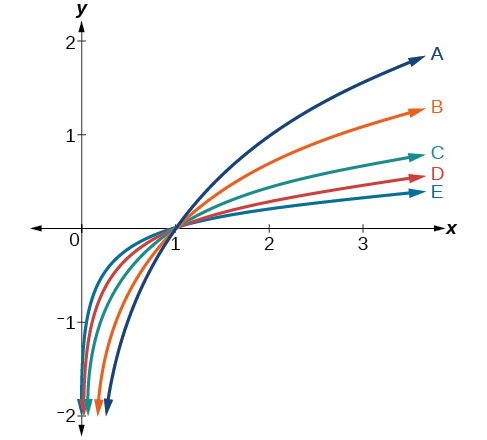
36. [latex]d(x)=log(x)[/latex]
37. [latex]f(x)=ln(x)[/latex]
38. [latex]g(x)=log_2(x)[/latex]
39. [latex]h(x)=log_5(x)[/latex]
40. [latex]j(x)=log_{25}(x)[/latex]
For the following exercises, write a logarithmic equation corresponding to the graph shown.
41. Use [latex]y=log_2(x)[/latex] as the parent function.
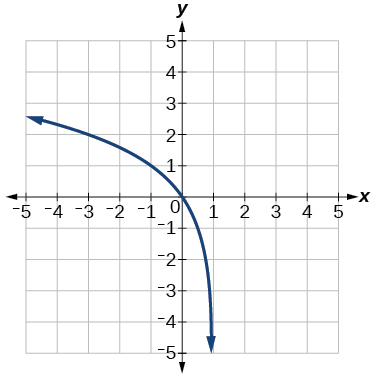
42. Use [latex]f(x)=log_5(x)[/latex] as the parent function.
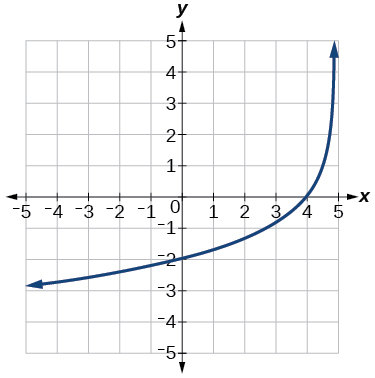
Numeric
For the following exercises, evaluate the base [latex]b[/latex] logarithmic expression without using a calculator.
43. [latex]log_6(\sqrt{6})[/latex]
44. [latex]log_3(\frac{1}{27})[/latex]
45. [latex]6log_8(4)[/latex]
46. [latex]log_2(\frac{1}{8})+4[/latex]
For the following exercises, evaluate the common logarithmic expression without using a calculator.
47. [latex]2log(100^{−3})[/latex]
48. [latex]log(1)+7[/latex]
For the following exercises, evaluate the natural logarithmic expression without using a calculator.
49. [latex]ln(1)[/latex]
50. [latex]25ln(e^{\frac{2}{5}})[/latex]
Extensions
51. Is [latex]x=0[/latex] in the domain of the function [latex]f(x)=log(x)[/latex]? If so, what is the value of the function when [latex]x=0[/latex]? Verify the result.
52. Is [latex]f(x)=0[/latex] in the range of the function [latex]f(x)=log(x)[/latex]? If so, for what value of [latex]x[/latex]? Verify the result.
53. Is there a number [latex]x[/latex] such that [latex]ln(x)=2[/latex]? If so, what is that number? Verify the result.
54. Let [latex]b[/latex] be any positive real number such that [latex]b≠1[/latex]. What must [latex]log_b1[/latex] be equal to? Verify the result.
55. What is the domain of the function [latex]f(x)=ln(\frac{x+2}{x−4})[/latex]? Discuss the result.
56. Use properties of exponents to find the x-intercepts of the function [latex]f(x)=log(x^2+4x+4)[/latex] algebraically. Show the steps for solving, and then verify the result by graphing the function.

